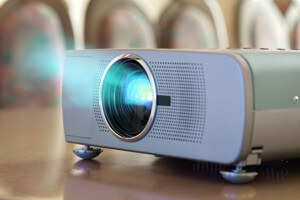
When it comes to shopping for digital signage, the process can seem a little overwhelming at first. It's a big investment, and you want to make sure you're picking the product that works best for your business, church, or organization. But how do you know what's best if you don't know what options are out there?
The type of display you choose is very important. You've probably heard the terms "LCD" and "LED", but if you don't really understand the difference, your search for the right technology could be more stressful than it needs to be. Rest assured, we're here to help! In this guide, we'll explain the key differences between LCD and LED technology, and compare them to existing projector technology, so you can start exploring the best fit for you.
LCD & LED Basics
- Liquid crystal displays (LCDs) create images by passing light through tiny liquid crystals inside the display. These liquid crystals tend to be quite fragile, and the amount needed for large modules can make displays incredibly heavy. For very large displays, you'll likely need to tile several displays together, which creates bezels in between each screen. This can cause viewers' attention to wane and detract from the product you're trying to showcase.
- Light-emitting diode (LED) displays are made up of tiny light bulbs that are placed in rows and columns. LED displays are typically much brighter than their LCD counterparts, and they stay brilliantly lit in ambient lighting. LED designs are typically much lighter in weight than LCD displays and can often be done without the distracting bezels that LCD displays need.
Digital Signage: Indoors or Outside?
The place where you plan to place your display will be a major player in your buying decision. If you're shooting for an outdoor display, LED wins hands down.
- LCD modules aren't built to withstand the elements. The material is too fragile for outdoor use. Liquid crystals also don't work well when the sunlight hits them, which would make your investment null and void if you went that route.
- LED modules, on the other hand, do quite well outdoors. In fact, that's essentially where they were designed to be placed. Improvements in technology have enabled LED displays to come indoors, too, making this a far more flexible option than LCD displays. Besides being far more durable, LED modules are able to display bright colors, even when the sunlight hits them.
- Projectors can be used indoors or out; however, there is not as much brightness and contrast as there is with either an LCD or an LED screen. The color and reflectivity of the surface that is being projected on will affect the image quality, and lines are typically not as sharp and colors not as vibrant.
Why Distance Makes a Difference
If your digital signage is meant for people to see it from far away, you'll want to go with an LED sign. While LCD modules have limited sizes, LED displays are available in a virtually limitless array of sizes.
The distance your viewers have from your sign makes a big difference in the way the image appears to them. The higher the resolution, the closer someone can stand to them without experiencing blurry or distorted images. Displays that are higher up or meant to be seen from far away will need to be much larger than signs that will be viewed up close. It's important to know where you'll be placing your sign—and how far away viewers will be for an optimal viewing experience.
LCD modules usually go by a 4/6/8 rule. This means the following factors go into play.
4: A person should not be a distance more than four times the height of the screen to read complex analytical data
6: A person should not be a distance of more than six times the height of the screen to read detailed viewing of common content
8: A person should not be a distance more than eight times the height of the screen to read general information.
- LED displays sometimes have a more complicated formula. Pixel pitch is a common term in the LED signage industry. It defines the distance between the LED bulbs. The lower the pixel pitch, the closer together the bulbs are, which means people can be closer to the display without experiencing distortion. To determine the ideal size of an LED screen, multiply the pixel pitch by 1,000. The calculation will give you a number—in meters—of the minimum viewing distance your audience should have from your sign before they begin to see the individual pixels.
- LCD panels come in 1080P and 4K UHD resolutions, which makes them great for up-close viewing, but they're not made for large distances. LED signs, on the other hand, are perfect for long-distance viewing. If you opt for a very low pixel pitch, they're also great for locations where your audience will be right near the action.
- Projector images get distorted the farther away the projector is from the surface it's projecting on. The brightness per square meter decreases, which causes an image to become darker and less vibrant. This is essentially because the farther away you move a projector from a surface, the larger the surface area the same amount of light has to cover.
How Energy Costs Add Up
The initial investment in your sign isn't the only thing you should think about; upkeep, maintenance, and energy expenses can add up. A cheaper sign could actually end up costing you more in the long run.
- LCD digital signage tends to draw a lot more power than its LED counterpart. Translation: the energy bills are usually a lot higher with this technology.
- LED digital signage is a greener solution and required far less energy consumption, which typically leads to a lower cost over the life of the sign when compared to a similar LCD display.
- Projectors can be cost-effective because they only have to be on some of the time. However, poor quality images can affect an organization's marketing efforts and reduce ROI, which essentially negates any cost savings that might be had.
Stewart Signs is your place for digital signage. With a team that's been doing signs for more than 50 years, we're proud to say we're America's go-to spot for incredible LED signage. Are you ready to learn more? Our LED sign pros are standing by and happy to answer any questions you may have. Reach out to us today!
